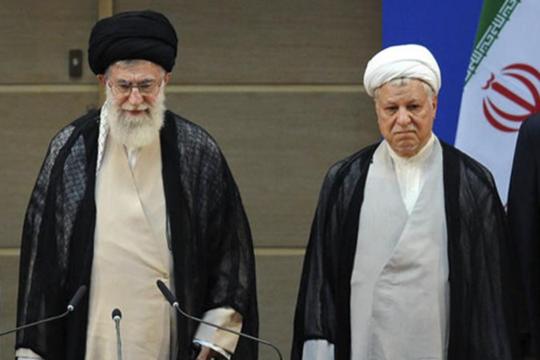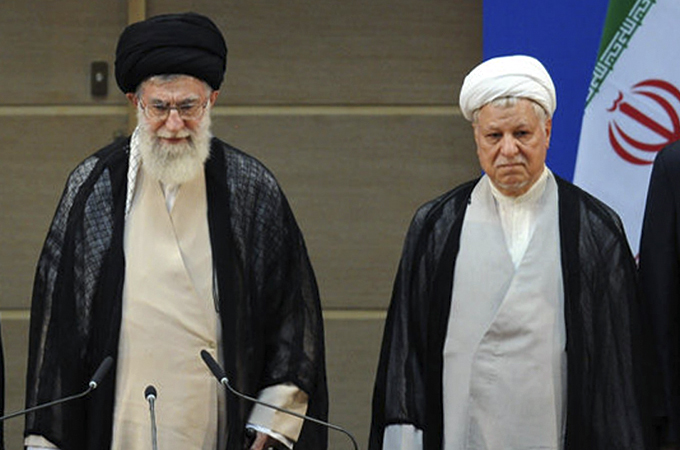
 |
There is no doubt that Rafsanjani’s decision to nominate himself is a development that outdoes every other electoral event in Iran and causes great confusion, starting with the fundamentalist mainstream trend from which a number of prominent icons like Ali Velayati, the former foreign minister and a close adviser to the supreme leader Ayatullah Khamene’i; Mohammad Bagher Ghalibaf, Tehran’s mayor; and Adil Haddad, Khamene’i’s son-in-law and former chair of the Shura Council announced their entry into the race.
It seems that the nomination received the blessing or tacit acceptance of the Supreme Leader. A few days before announcing his candidacy, Rafsanjani declared, "Without the [Supreme] Leader's approval of my participation, the results will be negative." He then emphasised, "Without [his] blessing, I will not enter this arena."
Rafsanjani’s late entry will cause widespread confusion as was in the case the 9th presidential elections in 2005 for his approach upset the fundamentalist mainstream trend and disrupted their plans. Heavily criticised by the reformists, especially those of the radical trend, Rafsanjani assisted the fundamentalists in the second municipal election in 2003 and in the seventh Shura Council elections in 2004; this resulted in their victory and eliminated the fundamentalists' disappointment in him due to his support for the Executives of Construction Party and Mohammad Khatami’s government. However, this convergence did not last long, and collapsed with the beginning of Rafsanjani’s campaign. In more a number of meetings with members of the fundamentalist trend, he said that he would not run in presidential elections and that he would leave it to the youth.
Now, as previously, Rafsanjani was very shrewd, deliberately spreading rumours that confirmed his candidacy as well as rumours that denied it. This made his candidacy – or the lack thereof – a fundamental matter in the elections. He then referred to his decision to run for president in a manner that suggested he had been forced to compete. "The issue of presidency currently occupies my mind," he said. "Although I want someone else to assume this responsibility, I believe that it is necessary for me to take this bitter medicine, and something that I was not interested in seems about to happen."
A reflection of Rafsanjani’s personality is his unpredictable alliances with enemies one day becoming friends the next. There are no permanent enemies, and no permanent friends. The tensions that characterised Rafsanjani’s relations with the reformist Participation Front at one time found an equivalent in relations with the fundamentalist Alliance of Builders of Islamic Iran, which advocated economic change as well as with President Ahmadinejad’s trend, which criticised the economic policies of the past 16 years, especially Rafsanjani’s free market policies.
In recent years, Rafsanjani realised that his political legacy might be in danger, confronted by the campaign of Ahmadinejad, who scathingly attacked Rafsanjani’s policies. Ahmadinejad’s policies were developed within the framework of two main responsibilities that came to the fore due to the deterioration of economic conditions and the associated increase of poverty, deprivation and lack of justice.
The scene is being repeated today in an astonishing way. The chaos that prevailed in 2005 gives a picture of the level of confusion that occurred. None of the candidates of the fundamentalist trend showed any desire to compete against Rafsanjani. Ultimately, four prominent candidates –Ali Velayati, Ali Larijani, Mohsen Rezaee, and Mohammad Bagher Ghalibaf – announced that they would run in the election if Rafsanjani was not a candidate. Despite Rezaee’s criticism of Rafsanjani on more than one occasion, he ultimately withdrew from the election. Ghalibaf, however, announced his nomination after closed meetings with the Head of the Expediency Council and declared Rafsanjani his main rival, believing he would win. But after the results of the first round of elections and the competition between Rafsanjani and Ahmadinejad, he called on his supporters to support Rafsanjani.
This recurrence presents many similarities but other elements have also shaped the Iranian political landscape of today, and their impact cannot be eliminated. The Rafsanjani of 2005 is not the Rafsanjani of 2013, and the changes that have occurred in his alliances and political positions have taken a sharp turn, nearly resulting in confrontation with the Supreme Leader during the 10th presidential elections in 2009. In the elections, Rafsanjani strongly supported Mir Hossein Mousavi, whose somewhat-leftist economic programmes failed when he was prime minister under Rafsanjani.
Since the 2009 elections, which were followed by protests against the re-election of Ahmadinejad, many have described Rafsanjani as "the godfather of sedition." This view is held by the leaders of the Revolutionary Guards, deputies in the Shura Council and those close to the Supreme Leader. Minister of intelligence Heydar Moslehi believes Rafsanjani plays an influential role in the "sedition events;" a few weeks ago, Moslehi reiterated his allegations without mentioning Rafsanjani by name.
Opponents and supporters continue to market the famous "letter incident," but each of them does so from their point of view. Rafsanjani’s supporters believe that "through his vision and experience, he recognised the threat posed by Ahmadinejad and predicted danger to the revolution, and thus warned against it." His opponents argue that the clashes that occurred in 2009 could be forecasted through a reading of the message that Rafsanjani addressed to the Supreme Leader in which he threatened to take to the streets in the event of Ahmadinejad’s re-election. Opponents view the corruption charges pressed by Ahmadinejad against the Rafsanjani family as having had great impact on the possibility of the protest. The proof of this is the content of Rafsanjani’s letter that contained veiled threats of hostile measures in the streets and universities. The letter read, "Even if I were to maintain my initial approach of patience, there is no doubt that there are people and parties will lose tolerance and the volcano will shift from the core to the society as we see examples of this in election rallies in the streets and universities." A deputy from the Shura Council interpreted Rafsanjani’s letter not as a response to accusations of corruption but rather as an attempt to influence the flow of the elections and enhance the position of Mir Hossein Mousavi. A fundamentalist member of the Shura Council, Hamid Rasaei, described Rafsanjani’s message as "the spark that threatened to cause a velvet coup." He also said, "It is not a new matter but has only been announced today." In this regard, Rasaei questioned Rafsanjani’s previous silence when the reformists, who are now his allies, accused him during the council's 6th session of more serious offences, the most serious of which was the murder of several Iranian intellectuals. These offences were cited by Akbar Ganji in his book, Ali-jenab-e Sarkhapush va Ali-jenabe Khakestari ("The Nobleman in the Red Robe and the Nobleman in the Grey Robe"). Ganji has now become a defender of Rafsanjani and his policies.
Although Rafsanjani said that he did not want to compare between Abulhassan Banisadr's government and the current government, and that he did not want it to have the same fate, he actually did make a comparison and regarded confronting Ahmadinejad as "an obligation to prevent the country from falling into the fate of that period." Therefore, it was not accidental that he recalled the events of 1981 that resulted in Banisadr’s isolation. How would he save the country from a conspiracy planned by the enemies of the revolution, asked Rafsanjani in his letter when Khamenei, the leader of the revolution, and the late Beheshti formed the triumvirate known as "Khomeini's three supporters" which was "initiated on the basis of the Imam’s guidance, and by keeping up with the revolutionary forces, especially the deputies of the first council and the Islamic Republican Party."
Rafsanjani did not succeed in establishing an alliance with the Supreme Leader to depose Ahmadinejad, but he managed his feud with his nemesis extremely sensitively. After the judiciary pursued Rafsanjani’s daughter, Faezeh, and his son, Mehdi, while the two were out of the country, they decided to return and submit to the rule of the judiciary and be detained. At the economic level, Rafsanjani had bet on the failure of Ahmadinejad’s economic policy after inflation hit unprecedented limits of 30%, according to the National Center for Statistics, or 40% according to the estimates of other economists.
Rafsanjani has now returned to the centre of the conflict and competition where significant questions are raised about Iran’s foreign role. He preferred to focus his attention on domestic issues rather than supporting Hezbollah in Lebanon. This position is widely supporters, as is clearly reflected in slogans enunciated in 2009 including, "Neither Gaza nor Lebanon, my soul is a sacrifice for Iran."
With resounding complaints and the impact of the slogan, "a resistant economy," public discussions have turned to address Rafsanjani’s economic positions that tried to move Iran to new debates, including modernisation and globalisation, especially after the collapse of the Soviet Union, and which focus on questions of identity and its ambiguities in Iran due to new global developments. This rotation and shift may be a return to the requirements of state reconstruction, which was witnessed in Iran after the end of the Iran- Iraq war when Rafsanjani’s team created a new discourse that called for attention to the processes of globalisation and change in foreign, economic and social policies. The government has defended its point of view, arguing that reconsideration of foreign policy is necessary for economic development, especially after the second Gulf War. The economic policy of the Executives of Construction Party was influenced by capitalism, economic liberalism, privatisation, liberalisation of the economy, and minimum state intervention in economic affairs, and sought coordination with international financial institutions.
A few weeks ago, Khamenei was setting terms for the next president. He declared that "Iran, as a great and resisting nation, needs a president that is brave enough to stand in the face of existing impudence in the international arena, and, at the same time, have programmes and wisdom at the domestic level without causing popular protests and tension, and express logical slogans based on reality."
Khamenei continued, defining the "magic mix" for the next president. He described someone that will have a different approach to Rafsanjani on the issues of economic liberalisation and foreign relations though he realises that the sensitive stage Iran is going through requires Rafsanjani’s shrewdness, and that the persisting internal political crisis requires a man with Rafsanjani’s gravitas.
Khamenei's blessing of Rafsanjani’s nomination indicates that Khamenei has concluded that his old friend, with whom he shared the secrets of the revolution and the republic and with whom he climbed up the ladder of power, holds the reins to the solution. But if the advice of Moselhi, a close friend of Khamenei, to "not make the mistake of thinking that the revolution has forgotten his role in the strife that occurred," is directed at Rafsanjani, their friendship has not been restored and things will end gently with the final stage of Rafsanjani’s experience through elections and political advocacy.
The second possibility implies that it is necessary to have a candidate that is revered by Khamenei. He should also be able to unite the fundamentalist trend and strongly compete with Rafsanjani. This cannot be Hassan Rouhani, who is known for his political and intellectual loyalty to Rafsanjani, and who has few chances within the fundamentalist trend. It also cannot be Ghalibaf, who is known for his strong respect for Rafsanjani. The focus then falls on Velayati who, despite his acknowledgment of Rafsanjani's status and influence, can still face him as a competitor.
On the Rafsanjani-Ahmadinejad front, a new chapter began in the ongoing confrontation almost a decade ago. Ahmadinejad’s close adviser, Rahim Mashaei, was nominated for the presidential race, and he entered the building of the Ministry of the Interior to register his name at the same time that Rafsanjani did.